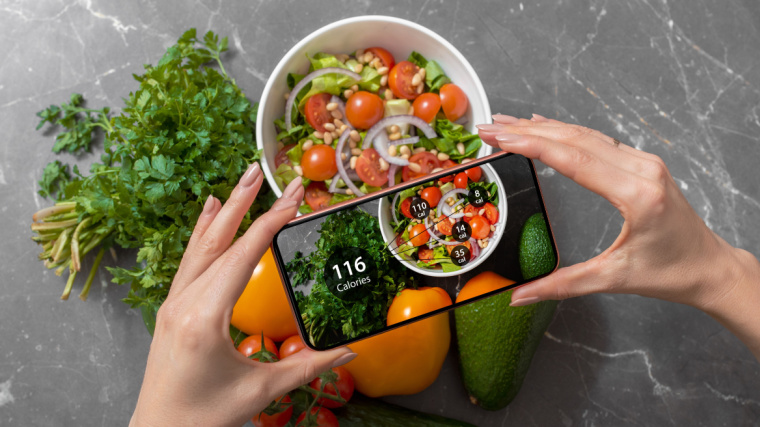Across the fitness industry, training and nutrition are often portrayed as inseparable from calories. Whether you’re counting how many calories you’re consuming in your meal prep or how many you’re “burning” on the treadmill, calorie counting is frequently encouraged.
Given the amount of attention dedicated specifically to calories within training circles, strength athletes can benefit tremendously from understanding exactly what we mean when we say calories. Is a calorie just a calorie? Or is there more to know about these units of energy measurement? Here’s what you need to know — but maybe didn’t know to ask — about the legendary calorie.

Editor’s Note: The content on BarBend is meant to be informative in nature, but it should not be taken as medical advice. When starting a new training regimen and/or diet, it is always a good idea to consult with a trusted medical professional. We are not a medical resource. The opinions and articles on this site are not intended for use as diagnosis, prevention, and/or treatment of health problems. They are not substitutes for consulting a qualified medical professional.
What Are Calories?
Far from being a mysterious force conspiring to add perhaps unwanted inches to your waistline, a calorie is simply a unit of energy. More specifically, what we commonly refer to as a calorie is actually shorthand for a kilocalorie. One kilocalorie is the amount of energy required to increase the temperature of one kilogram of water by one degree Celsius. (1)
In that sense, the definition of a calorie is like the definition of an inch or a centimeter — simply a unit of measurement.
How Many Calories Are in Each Macronutrient?
Macronutrients are the types of food that you get your calories — your energy — from. Here’s how much energy each of your macros contains.
- Protein: 4 calories per gram
- Carbohydrates: 4 calories per gram
- Fat: 9 calories per gram
Therefore, even if all calories function the same within your body, fat has more than double the per-gram caloric content of protein and carbohydrates. That’s not a bad thing; it’s simply a measure of energy potential.
Are All Calories the Same?
Once unused calories are converted into body fat, they are all essentially the same. Prior to this conversion, the calories you eat are quite distinct. From the moment food enters your body, the process of digesting the calories differs from one macronutrient to the next, and their energy is also harnessed to fuel different processes.
How the Body Processes Calories from Protein
The process of breaking down protein is rather labor-intensive for your body. The full process includes the hydrochloric acid and other stomach enzymes that begin to denature the protein, and the process of peristalsis that occurs in your stomach and intestines. (2)(3)
[Read More: 20 High-Protein, Low-Calorie Foods Worth Subbing Into Your Diet]
“Once the stomach has done its job releasing the acid and those bonds are broken, you have amino acids that can be absorbed into the bloodstream through cells in the intestines,” Gregory explains. “So those proteins’ amino acids — which could be called the building blocks of the body — can be shunted to different areas for your body to utilize them.”
How the Body Processes Calories from Carbs
The procedure for breaking down carbohydrates begins with enzymes in your saliva like amylase, which separates the carbohydrate chains into smaller molecules like glucose. Your body then releases insulin to direct that glucose into your cells where it can be utilized as energy. (4)

[Read More: Macronutrients Vs. Micronutrients — The Differences Explained]
“Carbohydrates are the preferred source of energy for the body because they don’t require as much investment in terms of ATP (adenosine triphosphate) production to break apart compared to fat or protein,” Gregory explains. “So your body will prefer to use carbohydrates as an energy source over the other two macronutrients when it’s available.”
How the Body Processes Calories From Fat
When fat enters your stomach, your pancreas secretes digestive enzymes and bile salts that emulsify the fat. Once the fat has been drastically reduced in size and enters your intestines, it is further absorbed through the processes of hydrolysis or micellization. This is also the site where your body extracts the fat-soluble vitamins. (5)
[Read More: Science-Backed Solutions For How to Burn Fat]
“The enterocytes are the cells that are in your intestines that shift the fat into your bloodstream,” Gregory explains. “It’s kind of like your body will drive the fat to certain places where it’s needed depending on the type of fat it is.”
What Is Calorie Quality?
Calorie quality refers to the overall nutrient quality of the calories you’re ingesting. This is where the concept of an empty calorie comes from. That’s when a calorie arrives in your body as a pure energy source while offering little else of value (think: micronutrients, vitamins, and minerals).
Calorie quality is also a concept worth paying attention to because it can determine how efficiently each calorie gets used.
Nutrient Content
A calorie that enters your body empty of other nutrients that aid metabolic processes — like vitamins and minerals — is strictly a source of energy. On the other hand, fruits, vegetables, whole grains, or lean protein will both provide you with energy and the means to maximize its usefulness.
[Read More: The Best Foods for Energy Before, During, and After Your Workouts]
“If you have a meal with fruits and vegetables, a nice piece of protein, and some sort of fat like olive oil or avocado, that’s a really nice, complex meal that might have only 500 calories,” Gregory says. “You’ll be receiving a lot more nutrient value through a meal like that than you would through 500 calories of hard candy.”
Fiber Content
The fiber content of your food consists of carbohydrates that pass through your body undigested because they can’t be broken down into sugar molecules. (6) In addition to reducing hunger without adding additional calories to your official tally, fiber also slows down the digestion process. This gives you more time to capitalize on your inbound calories before they are converted to body fat. (6)
[Read More: The 12 Best Greens Powders (Spring 2023 Update)]
“Fiber is the reason that complex carbohydrates take a little bit longer to digest than simple carbohydrates, like candy, sodas, and juices,” Gregory says. “Complex carbs will include fiber-containing foods like fruits, vegetables, and whole grains. Because the fiber is not broken down or digested, it takes longer for the calories that accompany that fiber to be absorbed.”
Glycemic Index
The glycemic index is a zero-to-100 scoring system used to calculate how quickly a food will increase your blood sugar. Consuming foods that are low on the glycemic index means that they won’t cause your blood sugar to abruptly spike. (7)
Foods containing protein and fat rank lower on the glycemic index than foods that are purely carbohydrates, which is why a cup of ice cream has a lower GI score than a cup of white rice. (7)
[Read More: Do You Really Need High Glycemic Carbs Around Your Workout?]
“Incorporating protein and fat into every meal is a great way to prevent sugar spikes,” Gregory says. “Lower glycemic index foods will generally be preferred from an overall health perspective just so that you’re maintaining what we call euglycemia to avoid those peaks and valleys of your blood sugar.”
Personal Enjoyment
Liking a food is, indeed, a good enough reason to eat it. Still, to ensure that you’re getting enough micronutrients and avoiding potential long-term health complications. To do this, you might want to have some compromises prepared to help your body tolerate particular foods better.
“If you’re going to have a cupcake with icing, try eating some peanut butter alongside the cupcake so that you’re including some fat to slow the absorption of glucose,” Gregory suggests.
[Read More: How Exercise Affects How the Body Uses Sugar]
Consider overall balance in your nutritional plan. “If you like candy, it is going to be broken down into glucose the same as any other carbohydrate,” Gregory explains. “It doesn’t matter if you get the carbohydrate from an apple or honey or hard candy — your body will break it down the same. But in terms of calorie quality, you’ll get more nutrition, vitamins, and minerals through having a balanced meal.”
Myths About Calories
If you’ve scrolled through fitness social media, you’ve likely found yourself contending with myths about calories that make it difficult to separate fact from fiction. Further complicating matters is how some of the myths may appear true over the short term. However, over the long term, these myths can be both wrong and harmful.
Myth 1: Calorie Restriction Always Helps With Weight Loss
A common fitness statement is that a pound of fat consists of approximately 3,500 calories. (8) Therefore, many say that losing body weight is a simple matter of creating a consistent caloric deficit to bring about weight loss. This makes sense on the surface and appears to be true in the short term. However, this strategy becomes problematic as time progresses.

[Read More: How to Calculate Your Macronutrients for Weight Loss]
“If a typical person requires 2,500 calories a day and they’re trying to lose weight through calorie restriction, they can restrict to 2,000 calories a day of pure sugar, and they’ll still lose weight because they’re restricting from their basal metabolic rate,” explains Gregory. “At some point, the body is going to recognize the danger and go into starvation mode, and then you won’t be able to lose weight nearly as consistently, if at all.”
Myth 2: All Calories Are the Same
The idea that all calories are identical is convenient when advice is to follow a non-stop pattern of restricting and burning calories. The blunt reality is that the calories from different macronutrient sources are digested differently, processed differently, and in some cases, even stored differently.
Myth 3: Weight Loss Is As Simple As Calories In Vs. Calories Out
Similarly to caloric restriction resulting in weight loss, weight loss is also routinely simplified into a formula of calories in and calories out. Subscribing to this thought process ignores the role of your metabolism in weight loss. This includes factoring in how the timing and variety of your food intake can manipulate the speed and efficiency with which you process food, as well as your stress levels, sleep, and other factors.
Your Takeaways
Calories are much more complex than meets the eye. The more you understand about the sources of your calories, the better you can tailor your nutrition plan.
- The digestion and processing of all three micronutrients — protein, fat, and carbs — is very different.
- The quality of a calorie is determined by the condition and type of the macronutrient it is and its nutrition content — that is, how many micronutrients it contains.
- The presence of fiber in carbohydrates slows their passage through the body and reduces the likelihood of the calories from carbohydrates being stored as body fat.
- Carbohydrates are likely to spike your blood sugar level; eating carbohydrates with fat and protein reduces the likelihood that these spikes will occur.
- Calorie restriction only works for a short time, as your body will lower its basal metabolic rate to resist starvation.
- The timing and frequency of meals can influence your basal metabolic rate; spacing meals far apart and extending fasting periods may alter your metabolism.
Upgrading Your Caloric Cognition
So, is a calorie just a calorie? Well, yes and no. Every calorie refers to a unit of energy, but not all the calories you eat impact your body the same way. The type of macronutrient you’re eating and the kinds of micronutrients the food contains (or doesn’t contain) all make the quality of each calorie different. So eat up — this time with myth-busting knowledge on your side.
References
- National Research Council (US) Committee on Diet and Health. Diet and Health: Implications for Reducing Chronic Disease Risk. Washington (DC): National Academies Press (US); 1989. 6, Calories: Total Macronutrient Intake, Energy Expenditure, and Net Energy Stores.
- Dill KA, Shortle D. Denatured states of proteins. Annu Rev Biochem. 1991;60:795-825.
- Patel KS, Thavamani A. Physiology, Peristalsis. [Updated 2023 Mar 12]. In: StatPearls [Internet]. Treasure Island (FL): StatPearls Publishing; 2023 Jan-.
- “Insulin Resistance & Prediabetes.” National Institute of Diabetes and Digestive and Kidney Diseases, 11 December 2023.
- Reddy P, Jialal I. Biochemistry, Fat Soluble Vitamins. [Updated 2022 Sep 19]. In: StatPearls [Internet]. Treasure Island (FL): StatPearls Publishing; 2023 Jan-.
- Lattimer JM, Haub MD. Effects of dietary fiber and its components on metabolic health. Nutrients. 2010 Dec;2(12):1266-89.
- Eleazu CO. The concept of low glycemic index and glycemic load foods as panacea for type 2 diabetes mellitus; prospects, challenges and solutions. Afr Health Sci. 2016 Jun;16(2):468-79.
- Thomas DM, Gonzalez MC, Pereira AZ, Redman LM, Heymsfield SB. Time to correctly predict the amount of weight loss with dieting. J Acad Nutr Diet. 2014 Jun;114(6):857-861.
Featured Image: Kaspars Grinvalds / Shutterstock
The post Is a Calorie Just a Calorie? An RD Weighs In appeared first on BarBend.

